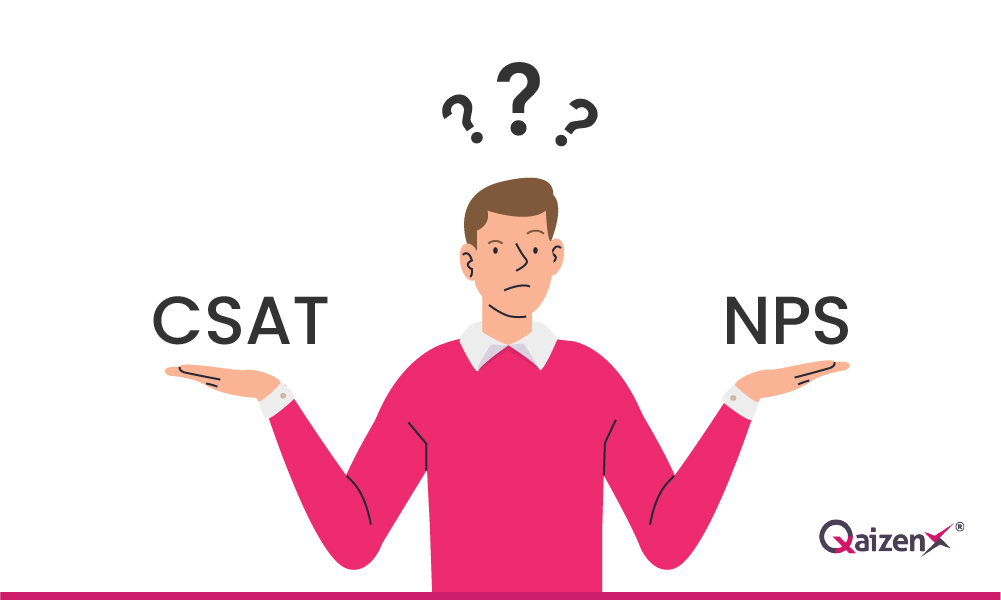Difference between NPS and CSAT | Which is Best?

When we speak about understanding customer experience and satisfaction, we naturally talk about two metrics: Customer Satisfaction Score (CSAT) and Net Promoter Score (NPS).
However, which one is most suitable for you?
While NPS and CSAT all measure how your company, products, and services are perceived by your customers, there are nuances that make one better than the other based on your use case and business goals.
In this article, we’ll explore their differences and help you understand how to use each for measuring your customer experience.
CSAT is Customer Satisfaction, which helps you measure how happy and satisfied customers are with the products they have used.
Wherein NPS is a Net Promoter Score, which helps you measure customer’s loyalty and how likely they are to recommend your product to their friends and family.
Customer satisfaction and net promoter score are the most effective measures of understanding customers’ wants and understanding their behaviour and experiences.
Customer Satisfaction:
If you want to know whether your customers are satisfied with the products or services you are providing, then you should go with the CSAT feedback. It helps you discover your product’s strengths and weaknesses.
The main aim of customer satisfaction is to capture customer’s expression on a specific interaction. Having a high CSAT score affects a company’s bottom line, team morale, and retention rates.
Customer satisfaction contains the 1-5 rating scale usually from 1(very dissatisfied) to 5(very satisfied). The scores for CSAT are calculated for responses 4(satisfied) and 5(very satisfied). For example, if you have 100 responses total and 80 are positive, your CSAT would be 80%.

The formula for calculating CSAT scores:

Net Promoter Score:
Without a doubt, loyal customers serve as key brand ambassadors for any business.
If you want to know how loyal your customers are, you need to take the NPS survey. You will gain an insight into your customers’ willingness to recommend your products.
An NPS provides a more comprehensive overview than CSAT. Moreover, it is intended to measure customer loyalty rather than customer satisfaction. Customers who score high on the NPS are most likely to be retained and their revenue will grow.
NPS responses are segmented into 3 groups as below.

- Promoters, whose responses are 9 or 10. They are Loyal and likely to repurchase from you. Also, they will recommend your product to their friends and family.
- Passives, whose responses are 7 or 8. They are satisfied but less enthusiastic to recommend. Also, they will speak less about the experience.
- Detractors, whose responses are from 0 to 6. They are unsatisfied and unhappy with your product/company. And hence can damage your brand by bad mouth publicity.
Net Promoter Score is used to calculate the promoters of a specific product/company whichever you are concerned with. The scale is from 0(Not at all likely to recommend) to 10 (Extremely Likely to recommend).
For example, if 10% of respondents are detractors, 20% are passives and 70% are promoters, your NPS score would be 70-10 = 60. Your NPS could range from -100 to 100.
The formula for calculating NPS:
Difference between CSAT and NPS:
- The NPS question focuses on future recommendations, whereas the CSAT questions focus on the current level of satisfaction.
- While CSAT measures short-term customer happiness, NPS focuses on long-term customer satisfaction and customer loyalty.
- CSAT gives points to specific areas whereas NPS gives an overall picture
Conclusion:
NPS and CSAT are complementary to one another. How to recognize which metric is better? And the answer is: When to use and which, will depend on your ultimate goals and ultimately can be better. Together, they provide the functionality needed to quantify and improve the overall experience your company provides. What really counts is what you do with the scores for improvement.
CSAT and NPS scores are a way to understand and drive the scores to take the action to key improvement areas.
Essential thoughts of using NPS is that customers are more likely to share negative thoughts about the brand/product/Services. Furthermore, by using NPS/CSAT you can track and monitor unhappy customers. By solving their problems you can convert them to happy ones.
This way you can take an analysis of your customers and as said by MIKE GOSPE:
“Whoever understands the customer best, WINS”
Start measuring your CSAT and NPS today. With QaizenX.
Recent Posts
- How People Analytics Can Utilize Data to Drive Business Results
- The Role of AI in Enhancing Employee Feedback Systems
- How Purpose-Built AI Can Help You Build A Great Customer Experience
- Why is Customer Sentiment Analysis Crucial to Your Business?
- Customer Experience Statistics You Need To Know for 2025 | CX Statistics 2024




